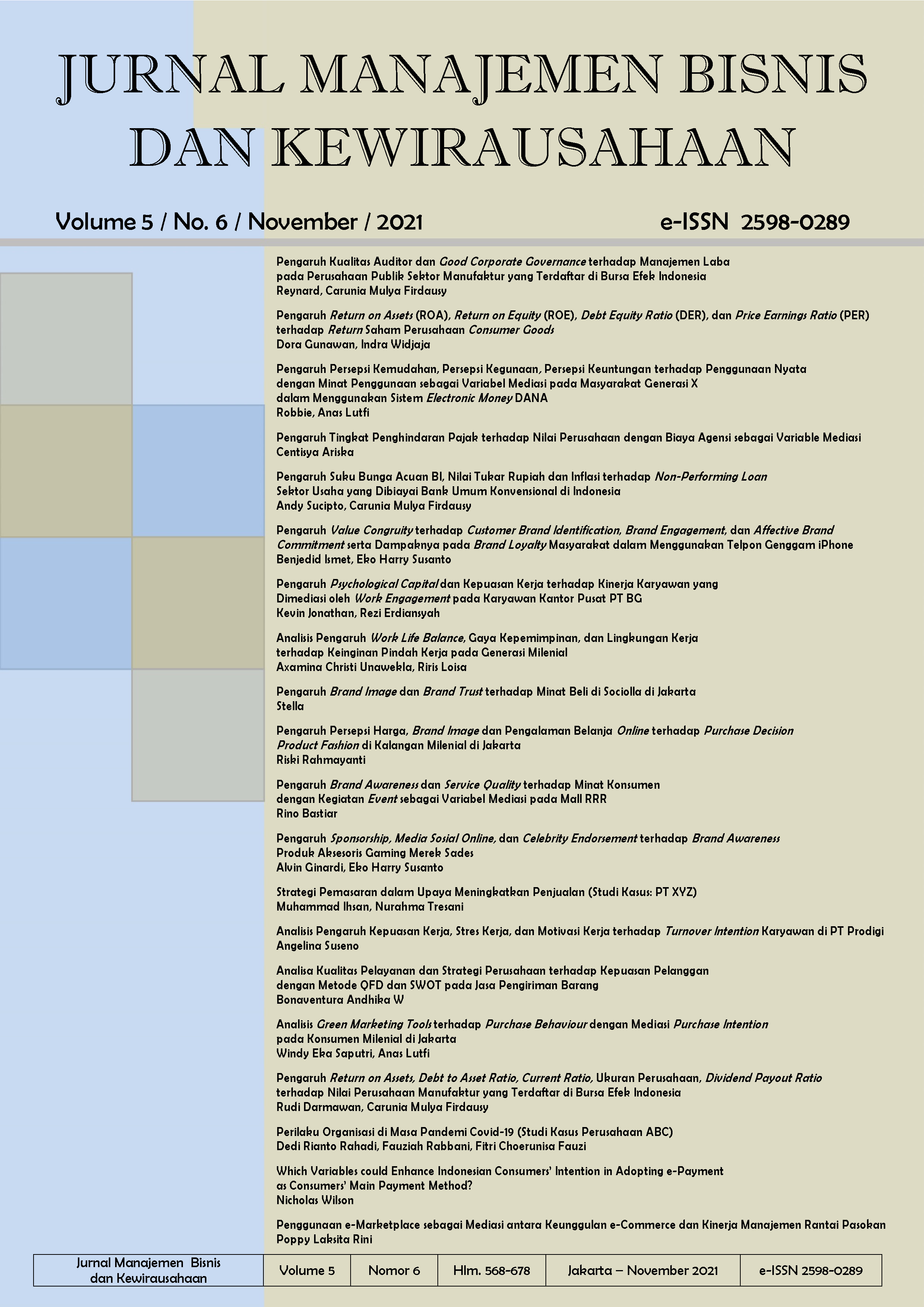Penggunaan e-Marketplace sebagai Mediasi antara Keunggulan e-Commerce dan Kinerja Manajemen Rantai Pasokan
Main Article Content
Abstract
The development of information technology has increased the use of E-Commerce at both upstream and downstream processes of supply chain management. One type of E-Commerce that was widely used by businesses and MSMEs is the E-Marketplace. E-marketplaces help to increase the efficiency and effectiveness of supply chain management activities, especially in the process of delivering goods or services to consumers. This study aims to see the relationship between the advantages of E-Commerce on the performance of supply chain management, with the role of E-Marketplace as an intermediary. This research examined the MSME sector in DIY Province, with a sample of 160 units has been taken. Based on the path analysis technique by using SPSS software, it was found that there was a positive and significant direct influence between the advantages of E-commerce on the supply chain management performance with the direct effect value of 0.189. Furthermore, there was also the role of using E-Marketplace as a mediating variable on the indirect effect of E-commerce advantages on supply chain management performance with the indirect value of 0.195.
Perkembangan teknologi informasi telah meningkatkan penggunaan E-Commerce dalam rantai pasokan di hulu maupun di hilir proses. Salah satu jenis E-Commerce yang banyak digunakan oleh pelaku bisnis dan UMKM adalah E-Marketplace. E-marketplace mampu meningkatkan efisiensi dan efektivitas aktivitas manajemen rantai pasokan khususnya dalam proses penyampaian barang atau jasa ke konsumen. Penelitian ini bertujuan untuk melihat hubungan antara keunggulan yang terdapat pada E-Commerce terhadap kinerja manajemen rantai pasokan, dengan penggunaan E-Marketplace perantara. Penelitian ini meneliti sektor UMKM di Provinsi DIY, dengan sampel yang diambil sebanyak 160 unit UMKM. Berdasarkan Teknik analisis jalur (Path Analysis) didapatkan bahwa terdapat pengaruh secara langsung yang positif dan signifikan antara keunggulan e-commerce terhadap kinerja manajemen rantai pasokan dengan nilai direct effect sebesar 0.189. Serta terdapat pula peran penggunaan E-Marketplace sebagai variabel mediasi pada pengaruh tidak langsung antara keunggulan e-commerce terhadap kinerja manajemen rantai pasokan dengan nilai indirect effect sebesar 0.195.
Article Details
This work is licensed under a Jurnal Manajemen Bisnis dan Kewirausahaan Creative Commons Attribution-ShareAlike 4.0 International License.
References
Alrubaiee, L., Alshaibi, H., & Al-Bayati, Y. (2012). Relationship between B2B e-commerce benefits, e-marketplace usage and supply chain management relationship between B2B e-commerce benefits, e-marketplace usage and supply chain management. Global Journal of Management and Business Research, 12(9), 23–36. https://globaljournals.org/GJMBR_Volume12/4-Relationship-between-B2B-E-Commerce.pdf
Alzahrani, J. (2019). The impact of e-commerce adoption on business strategy in Saudi Arabian small and medium enterprises (SMEs). Review of Economics and Political Science, 4(1), 73–88. https://doi.org/10.1108/reps-10-2018-013
Awad, E. M. (2007). Electronic commerce from vision to fulfillment (3rd ed.). Pearson.
Balakrishnan, A., & Geunes, J. (2004). Collaboration and coordination in supply chain management and e-commerce. Production and Operations Management, 13(1), 1–2. https://doi.org/10.1111/j.1937-5956.2004.tb00140.x
Chaffey, D. (2009). E-business and e-commerce management: Strategy, implementation and practice (4th ed.). Pearson.
Chong, W. K., Shafaghi, M., Woollaston, C., & Lui, V. (2010). B2B e-marketplace: An e-marketing framework for B2B commerce. Marketing Intelligence and Planning, 28(3), 310–329. https://doi.org/10.1108/02634501011041444
Delfmann, W., Albers, S., & Gehring, M. (2002). The impact of electronic commerce on logistics service providers. International Journal of Physical Distribution and Logistics Management, 32(3), 203–222. https://doi.org/10.1108/09600030210426539
Dou, W., & Chou, D. C. (2002). A structural analysis of business-to-business digital markets. Industrial Marketing Management, 31(2), 165–176. https://doi.org/10.1016/S0019-8501(01)00177-8
Eng, T. Y. (2004). The role of e-marketplaces in supply chain management. Industrial Marketing Management, 33(2), 97–105. https://doi.org/10.1016/S0019-8501(03)00032-4
Golicic, S. L., Davis, D. F., McCarthy, T. M., & Mentzer, J. T. (2002). The impact of e-commerce on supply chain relationships. International Journal of Physical Distribution and Logistics Management, 32(10), 851–871. https://doi.org/10.1108/09600030210455447
Guang, Y. (2012). Relationships between E-commerce and supply chain management. Advances in Intelligent and Soft Computing, 165 AISC, 653–658. https://doi.org/10.1007/978-3-642-29637-6_87
Gunasekaran, A., Patel, C., and Tirtiroglu, E. (2001). Performance measures and metrics in a supply chain environment. International Journal of Operations & Production Management, 21(1/2), 71–87. https://doi.org/10.1108/01443570110358468
Hair, Joseph F., et al. (2009). Multivariate data analysis: A global perspective (7th ed.). Prentice Hall.
Harsono, A. (2014). The impact of e-commerce in supply chain management at Dell Inc. Journal of Multidisciplinary Engineering Science and Technology, 1(3), 3159–40.
Hoffman, D. L., & Novak, T. P. (2000). How to acquire customers on the web. Harvard Business Review, 78(3), 179–188, 218.
Kareem, T., Owomoyela, S., & Oyebamiji, F. (2014). Electronic commerce and business performance: An empirical investigation of business organizations in Nigeria. International Journal of Academic Research in Business and Social Sciences, 4(8), 215–223. https://doi.org/10.6007/ijarbss/v4-i8/1090
Koch, H. A. (2003). Business-to-business electronic marketplaces: Membership and use drivers. ProQuest Dissertations and Theses, December, 284. http://ezproxy.umuc.edu/login?url=https://search.proquest.com/docview/305240694?accountid=14580%0Ahttp://sfx.umd.edu/uc?url_ver=Z39.88-2004&rft_val_fmt=info:ofi/fmt:kev:mtx:dissertation&genre=dissertations+%26+theses&sid=ProQ:ABI%2FINFORM+Global&atitle=&tit
Mentzer, J. T., DeWitt, W., Keebler, J. S., Min, S., Nix, N. W., Smith, C. D., & Zacharia, Z. G. (2001). Defining supply chain management. Journal of Business Logistics, 22(2), 1–25.
Porter, M. E., & M. (2001). Strategy and the internet. Harvard Business Review, 79(3), 63–78.
Ramanathan, R., Ramanathan, U., & Hsiao, H. L. (2012). The impact of e-commerce on Taiwanese SMEs: Marketing and operations effects. International Journal of Production Economics, 140(2), 934–943. https://doi.org/10.1016/j.ijpe.2012.07.017
Schneider, G. (2006). Electronic commerce (6th ed.). Thomson Learning Inc.
Turban, E., Outland, J., King, D., Lee, J. K., Liang, T. P., & Turban, D. C. (2017). Electronic commerce 2018: A managerial and social networks perspective. Springer.
Turban, E, & Volonino, L. (2009). Information technology for management: Improving performance in the Digital Economy. Wiley.
Van der Vorst, J. G. A. J., Van Dongen, S., Nouguier, S., & Hilhorst, R. (2002). E-business initiatives in food supply chains; Definition and typology of electronic business models. International Journal of Logistics Research and Applications, 5(2), 119–138. https://doi.org/10.1080/13675560210148641
Zhu, K., & Kraemer, K. L. (2002). E-commerce metrics for net-enhanced organizations: Assessing the value of e-commerce to firm performance in the manufacturing sector. Information Systems Research, 13(3), 275–295. https://doi.org/10.1287/isre.13.3.275.82


